Nicola Griffith's Blog, page 109
November 13, 2012
The business of writing: a one-day workshop December 2
Publishing is in the throes of huge change and it's hard to keep up with the choices available for writers--of any level and genre. Should we go with a lithe, adaptable independent publisher? Should we stick with a Big Five beast (which, as recently as last month, was the Big Six--which should tell you something about the speed of change)? Should we go with the new 800 lb gorilla, Amazon? Should we self-publish? If we do self-publish, should we consider crowd-funding?
Clarion West will hold a one-day workshop in Seattle on Sunday, December 2, on The Business of Writing. If I had the time (I'm in the thick of Hild revisions, so sadly I don't), this workshop is something I'd consider myself.
Amazon Publishing is one of the industry's disruptive forces (with all the positive and negatives associated with the phrase). This is your chance to talk to some of the people who are making decisions there--editors, publishers, and one of their bestselling authors. As Kelley points out, "Every writer needs to understand the business, not just the craft. We’re all responsible for our own careers, and today writers have more options than ever before. It’s an exciting, challenging, and potentially confusing landscape... Hear about the business from folks who are in it daily; get your questions answered; and come away with the big picture of the possibilities for all of us in the new publishing frontier."
If you're in or near Seattle early next month, seriously, think about this. Info below.
Workshop description:
This nuts-and-bolts workshop will provide emerging writers useful tips on how to make a living writing popular fiction. Editors and publishers from Amazon Publishing will share a behind-the-scenes perspective on publishing today, and bestselling author Robert Ferrigno will pass on skills and insights coming from his twenty years of professional experience. Topics covered include research techniques, time management, storyboarding and outlining, marketing, and learning from feedback.
Robert Ferrigno has written twelve best-selling thrillers, including The Horse Latitudes and Heartbreaker. His work has been nominated for the Edgar and the Silver Dagger. He thinks good writing, regardless of genre, is clear, resonant, and packs an emotional punch.
Cost is a nonrefundable fee of $140.
Registration is limited to 12 students
Clarion West will hold a one-day workshop in Seattle on Sunday, December 2, on The Business of Writing. If I had the time (I'm in the thick of Hild revisions, so sadly I don't), this workshop is something I'd consider myself.
Amazon Publishing is one of the industry's disruptive forces (with all the positive and negatives associated with the phrase). This is your chance to talk to some of the people who are making decisions there--editors, publishers, and one of their bestselling authors. As Kelley points out, "Every writer needs to understand the business, not just the craft. We’re all responsible for our own careers, and today writers have more options than ever before. It’s an exciting, challenging, and potentially confusing landscape... Hear about the business from folks who are in it daily; get your questions answered; and come away with the big picture of the possibilities for all of us in the new publishing frontier."
If you're in or near Seattle early next month, seriously, think about this. Info below.
Workshop description:
This nuts-and-bolts workshop will provide emerging writers useful tips on how to make a living writing popular fiction. Editors and publishers from Amazon Publishing will share a behind-the-scenes perspective on publishing today, and bestselling author Robert Ferrigno will pass on skills and insights coming from his twenty years of professional experience. Topics covered include research techniques, time management, storyboarding and outlining, marketing, and learning from feedback.
Robert Ferrigno has written twelve best-selling thrillers, including The Horse Latitudes and Heartbreaker. His work has been nominated for the Edgar and the Silver Dagger. He thinks good writing, regardless of genre, is clear, resonant, and packs an emotional punch.
Cost is a nonrefundable fee of $140.
Registration is limited to 12 students
Published on November 13, 2012 10:15
November 10, 2012
We're back...
We left the country for a few days. We were invited up to Vancouver: missing the election seemed like a bonus. Not only did we have a marvellous time but we got home to find that the American People had voted in ways that pleased us. And the sun was shining. Life is damn good.
Here's a pic of part of our experience:
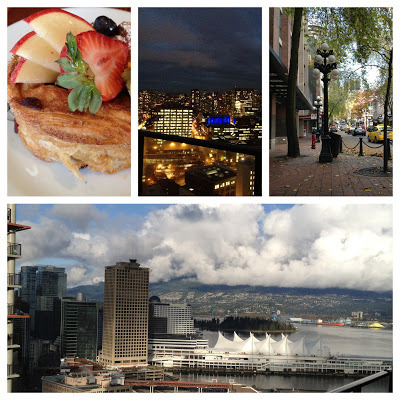 Three of these shots are of Gastown, two taken from the apartment where we stayed. Gastown reminds me of Pioneer Square and Belltown in Seattle. But...more. More cosmopolitan, more sharp, more busy, more interesting. More expensive. If I won the lottery I think I could spend a lot of time there. As it is, I suspect we'll be going back sooner rather than later. The pastry was from Thomas Haas in Kitsilano: if you like a good patisserie, you should go.
Three of these shots are of Gastown, two taken from the apartment where we stayed. Gastown reminds me of Pioneer Square and Belltown in Seattle. But...more. More cosmopolitan, more sharp, more busy, more interesting. More expensive. If I won the lottery I think I could spend a lot of time there. As it is, I suspect we'll be going back sooner rather than later. The pastry was from Thomas Haas in Kitsilano: if you like a good patisserie, you should go.
Thanks to all the people who made us so welcome.
In a couple of days I'll have more to say about some of that election stuff we avoided. For now, it was a delight to get away and it's lovely to be back.
Here's a pic of part of our experience:
 Three of these shots are of Gastown, two taken from the apartment where we stayed. Gastown reminds me of Pioneer Square and Belltown in Seattle. But...more. More cosmopolitan, more sharp, more busy, more interesting. More expensive. If I won the lottery I think I could spend a lot of time there. As it is, I suspect we'll be going back sooner rather than later. The pastry was from Thomas Haas in Kitsilano: if you like a good patisserie, you should go.
Three of these shots are of Gastown, two taken from the apartment where we stayed. Gastown reminds me of Pioneer Square and Belltown in Seattle. But...more. More cosmopolitan, more sharp, more busy, more interesting. More expensive. If I won the lottery I think I could spend a lot of time there. As it is, I suspect we'll be going back sooner rather than later. The pastry was from Thomas Haas in Kitsilano: if you like a good patisserie, you should go.Thanks to all the people who made us so welcome.
In a couple of days I'll have more to say about some of that election stuff we avoided. For now, it was a delight to get away and it's lovely to be back.
Published on November 10, 2012 22:25
November 5, 2012
Painting Bebbanburg
A few weeks ago I started thinking about Bebbanburg. I began drawing maps of what I thought the fort might have looked like in Hild's time. But all I had was a mechanical pencil (not even mine; left behind by a friend), a Sharpie past its best, and two highlighters (turquoise and florescent orange). The results were less than appealing:
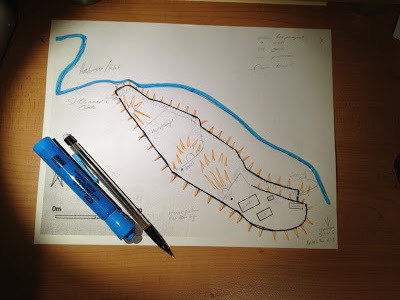 plan of Bebbanburg (this, like much the following, based on info from a nifty booklet published by the Bamburgh Research Project)It looks like a hairy foot next to a piece of yarn. (If you really want to you can click on the image--on all of them--to enlarge it though I'm not sure I'd recommend it.)
plan of Bebbanburg (this, like much the following, based on info from a nifty booklet published by the Bamburgh Research Project)It looks like a hairy foot next to a piece of yarn. (If you really want to you can click on the image--on all of them--to enlarge it though I'm not sure I'd recommend it.)
So I started thinking about what I needed to make pretty pictures. The problem: I haven't made art since I was a pre-teen. Decades ago. But my birthday was coming up so I got someone to give me a cheap kids' all-purpose art set (ages 6 and up! 120 pieces! including no-stab plastic scissors!) and added a set of 24 chalk pastels, an enormous pad of newsprint, a small spiral-bound sketch book, and one charcoal pencil.
Despite the 120 pieces, it turns out that all I want to use are the paints (12 colours!) and the pastels. They're deliciously messy and imprecise, just like my current notions of Bebbanburg:
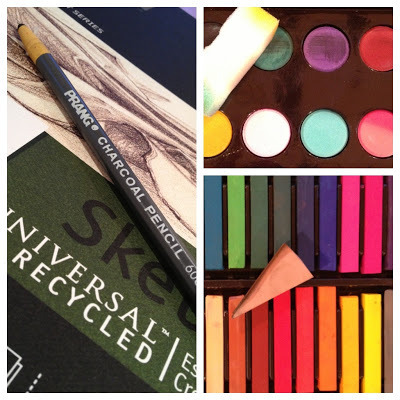 12 watercolours, 24 square chalk pastels, 1 pencil: all you need--plus a foam thing to smear the pastels aboutHere, for your delectation and delight (uh huh), are my two very first efforts, both ah, impressionistic views of Bebbanburg. Let's all hope I improve because, yes, I will be tormenting you with this stuff periodically.
12 watercolours, 24 square chalk pastels, 1 pencil: all you need--plus a foam thing to smear the pastels aboutHere, for your delectation and delight (uh huh), are my two very first efforts, both ah, impressionistic views of Bebbanburg. Let's all hope I improve because, yes, I will be tormenting you with this stuff periodically.
The first is paint, dabbed on with a sponge (the paint brush that came with the set was rubbish so I threw it away). I was going to eat lunch then play with my new purchases but I got halfway through my bowl of stew and couldn't resist. I swapped my spoon to my left hand, dipped a sponge in my water glass, flipped open the box and the sketch pad and just...began:
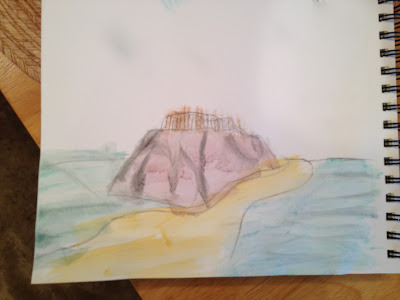 Bebbanburg from the southI'm guessing it's hard to tell what I was aiming for, so I'll explain. Bebbanburg was built (as Bamburgh Castle is now) on an outcrop of volcanic rock towering ninety feet above the farmland (on the left of this picture) and sea (on the right). At high tide that narrow strip of beach would have disappeared, and the sea lapped at the rock. The fort was on the top, ringed by a box pallisade, a kind of double wooden fence. This picture was, for me, an attempt to get a sense of the fort's sheer isolation from and dominating position over the surroundings. It was almost impregnable.
Bebbanburg from the southI'm guessing it's hard to tell what I was aiming for, so I'll explain. Bebbanburg was built (as Bamburgh Castle is now) on an outcrop of volcanic rock towering ninety feet above the farmland (on the left of this picture) and sea (on the right). At high tide that narrow strip of beach would have disappeared, and the sea lapped at the rock. The fort was on the top, ringed by a box pallisade, a kind of double wooden fence. This picture was, for me, an attempt to get a sense of the fort's sheer isolation from and dominating position over the surroundings. It was almost impregnable.
But then I itched to see inside, so after a couple of beers I tried again, this time with the pastels:
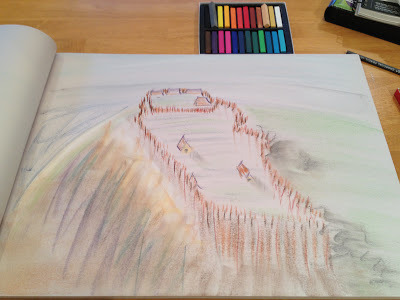 bird's eye view of Bebbanburg from the northI couldn't convey the height of the rock and the strength of the fortifications. And those dark smears on the right are meant to be shadow thrown by the rock. Ah, well. When it came to filling in details inside the pallisade, my visual brain failed. I know what should be there--rocky outcrops towards the south, and metal workshops (armourers, goldsmiths), a byre, a couple of towers--but I just went blank. Here's the bit of detail I did manage:
bird's eye view of Bebbanburg from the northI couldn't convey the height of the rock and the strength of the fortifications. And those dark smears on the right are meant to be shadow thrown by the rock. Ah, well. When it came to filling in details inside the pallisade, my visual brain failed. I know what should be there--rocky outcrops towards the south, and metal workshops (armourers, goldsmiths), a byre, a couple of towers--but I just went blank. Here's the bit of detail I did manage:
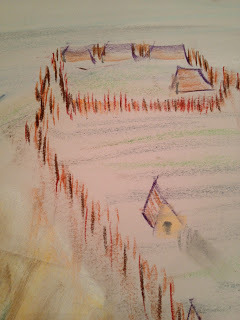 detail of pastel sketch of BebbanburgI imagine this is how it feels for non-writers who think, Ha, I'm going to write a story now! And then haven't the faintest idea how to begin. I thought I'd just able to, y'know, do it, without thinking. Wrong. Visual artists, my hat's off to you. (Also, sorry for making you flinch and possibly spoiling your lunch.)
detail of pastel sketch of BebbanburgI imagine this is how it feels for non-writers who think, Ha, I'm going to write a story now! And then haven't the faintest idea how to begin. I thought I'd just able to, y'know, do it, without thinking. Wrong. Visual artists, my hat's off to you. (Also, sorry for making you flinch and possibly spoiling your lunch.)
So then I went back to dabbling in the paints with the sponge, this time trying to figure out how the rock with the fort on top might look from Lindisfarne:
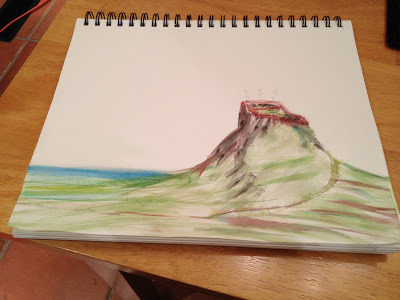 Bebbanburg from LindisfarneI'd already used my two blues for the sea and, as I don't know how to mix them yet, I was sadly puzzled as to what to do for the sky. Clearly I have a long way to go as an artist. But, eh, I'm having enormous fun and making a fabulous mess...
Bebbanburg from LindisfarneI'd already used my two blues for the sea and, as I don't know how to mix them yet, I was sadly puzzled as to what to do for the sky. Clearly I have a long way to go as an artist. But, eh, I'm having enormous fun and making a fabulous mess...

 plan of Bebbanburg (this, like much the following, based on info from a nifty booklet published by the Bamburgh Research Project)It looks like a hairy foot next to a piece of yarn. (If you really want to you can click on the image--on all of them--to enlarge it though I'm not sure I'd recommend it.)
plan of Bebbanburg (this, like much the following, based on info from a nifty booklet published by the Bamburgh Research Project)It looks like a hairy foot next to a piece of yarn. (If you really want to you can click on the image--on all of them--to enlarge it though I'm not sure I'd recommend it.)So I started thinking about what I needed to make pretty pictures. The problem: I haven't made art since I was a pre-teen. Decades ago. But my birthday was coming up so I got someone to give me a cheap kids' all-purpose art set (ages 6 and up! 120 pieces! including no-stab plastic scissors!) and added a set of 24 chalk pastels, an enormous pad of newsprint, a small spiral-bound sketch book, and one charcoal pencil.
Despite the 120 pieces, it turns out that all I want to use are the paints (12 colours!) and the pastels. They're deliciously messy and imprecise, just like my current notions of Bebbanburg:
 12 watercolours, 24 square chalk pastels, 1 pencil: all you need--plus a foam thing to smear the pastels aboutHere, for your delectation and delight (uh huh), are my two very first efforts, both ah, impressionistic views of Bebbanburg. Let's all hope I improve because, yes, I will be tormenting you with this stuff periodically.
12 watercolours, 24 square chalk pastels, 1 pencil: all you need--plus a foam thing to smear the pastels aboutHere, for your delectation and delight (uh huh), are my two very first efforts, both ah, impressionistic views of Bebbanburg. Let's all hope I improve because, yes, I will be tormenting you with this stuff periodically.The first is paint, dabbed on with a sponge (the paint brush that came with the set was rubbish so I threw it away). I was going to eat lunch then play with my new purchases but I got halfway through my bowl of stew and couldn't resist. I swapped my spoon to my left hand, dipped a sponge in my water glass, flipped open the box and the sketch pad and just...began:
 Bebbanburg from the southI'm guessing it's hard to tell what I was aiming for, so I'll explain. Bebbanburg was built (as Bamburgh Castle is now) on an outcrop of volcanic rock towering ninety feet above the farmland (on the left of this picture) and sea (on the right). At high tide that narrow strip of beach would have disappeared, and the sea lapped at the rock. The fort was on the top, ringed by a box pallisade, a kind of double wooden fence. This picture was, for me, an attempt to get a sense of the fort's sheer isolation from and dominating position over the surroundings. It was almost impregnable.
Bebbanburg from the southI'm guessing it's hard to tell what I was aiming for, so I'll explain. Bebbanburg was built (as Bamburgh Castle is now) on an outcrop of volcanic rock towering ninety feet above the farmland (on the left of this picture) and sea (on the right). At high tide that narrow strip of beach would have disappeared, and the sea lapped at the rock. The fort was on the top, ringed by a box pallisade, a kind of double wooden fence. This picture was, for me, an attempt to get a sense of the fort's sheer isolation from and dominating position over the surroundings. It was almost impregnable.But then I itched to see inside, so after a couple of beers I tried again, this time with the pastels:
 bird's eye view of Bebbanburg from the northI couldn't convey the height of the rock and the strength of the fortifications. And those dark smears on the right are meant to be shadow thrown by the rock. Ah, well. When it came to filling in details inside the pallisade, my visual brain failed. I know what should be there--rocky outcrops towards the south, and metal workshops (armourers, goldsmiths), a byre, a couple of towers--but I just went blank. Here's the bit of detail I did manage:
bird's eye view of Bebbanburg from the northI couldn't convey the height of the rock and the strength of the fortifications. And those dark smears on the right are meant to be shadow thrown by the rock. Ah, well. When it came to filling in details inside the pallisade, my visual brain failed. I know what should be there--rocky outcrops towards the south, and metal workshops (armourers, goldsmiths), a byre, a couple of towers--but I just went blank. Here's the bit of detail I did manage: detail of pastel sketch of BebbanburgI imagine this is how it feels for non-writers who think, Ha, I'm going to write a story now! And then haven't the faintest idea how to begin. I thought I'd just able to, y'know, do it, without thinking. Wrong. Visual artists, my hat's off to you. (Also, sorry for making you flinch and possibly spoiling your lunch.)
detail of pastel sketch of BebbanburgI imagine this is how it feels for non-writers who think, Ha, I'm going to write a story now! And then haven't the faintest idea how to begin. I thought I'd just able to, y'know, do it, without thinking. Wrong. Visual artists, my hat's off to you. (Also, sorry for making you flinch and possibly spoiling your lunch.)So then I went back to dabbling in the paints with the sponge, this time trying to figure out how the rock with the fort on top might look from Lindisfarne:
 Bebbanburg from LindisfarneI'd already used my two blues for the sea and, as I don't know how to mix them yet, I was sadly puzzled as to what to do for the sky. Clearly I have a long way to go as an artist. But, eh, I'm having enormous fun and making a fabulous mess...
Bebbanburg from LindisfarneI'd already used my two blues for the sea and, as I don't know how to mix them yet, I was sadly puzzled as to what to do for the sky. Clearly I have a long way to go as an artist. But, eh, I'm having enormous fun and making a fabulous mess...
Published on November 05, 2012 08:57
November 2, 2012
Brightly-coloured lusciousness
Still having fun fooling about with Diptic. So here are two that I made while having a conversation about Seattle weather.
If you don't like the weather, wait ten minutes: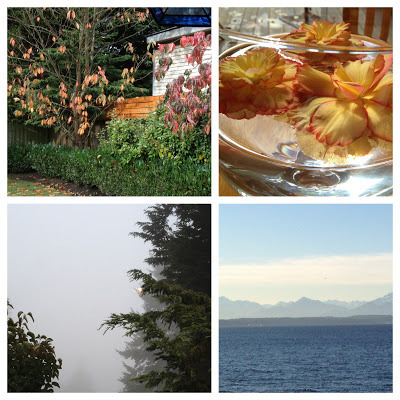 And while you're indoors, waiting for the weather:
And while you're indoors, waiting for the weather:
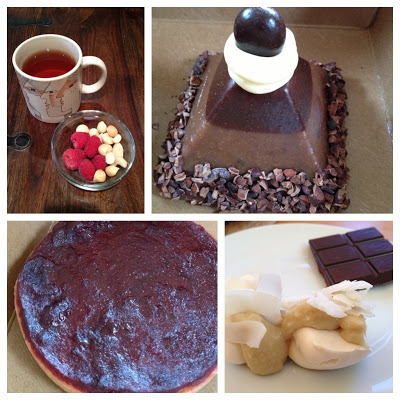 And a bonus pic, a hint for a blog post I hope to do next week:
And a bonus pic, a hint for a blog post I hope to do next week:
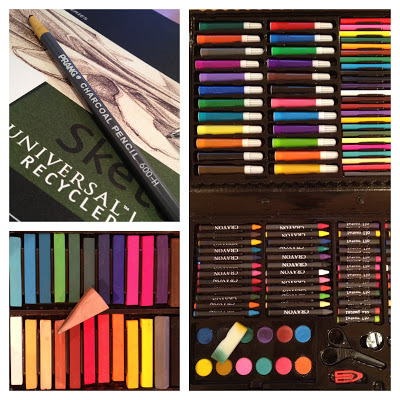

If you don't like the weather, wait ten minutes:
 And while you're indoors, waiting for the weather:
And while you're indoors, waiting for the weather:
 And a bonus pic, a hint for a blog post I hope to do next week:
And a bonus pic, a hint for a blog post I hope to do next week:

Published on November 02, 2012 12:55
October 30, 2012
My new toy: a longseax
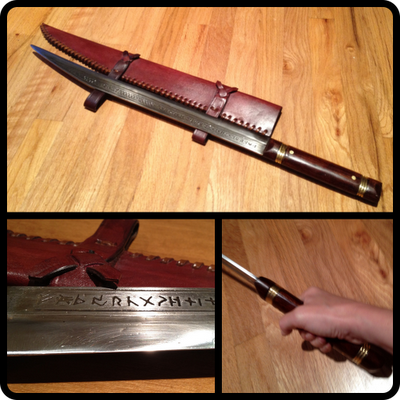
My new toy is a replica of the seax of Beagnoth, thought to be of ninth-century Anglo-Saxon origin. Though in my opinion* (neither particularly expert nor particularly humble) it could very well be tenth-century.
It's huge, nearly as long as an early gladius, about 29" long--including the hilt, which is around 7". In a pinch I could use it two-handed but for a thick-thewed thegn it would be a one-hander. It's heavy--heavier than a gladius because it doesn't have that pinched waist about a third of the way down. I'd say it weighs a smidge under 2 lbs. The blade is single-edged--the longer side is the sharp one. Runes run the length of the blade. In the original, they were inlaid with gold wire.
To convey the size, here it is on a chair:
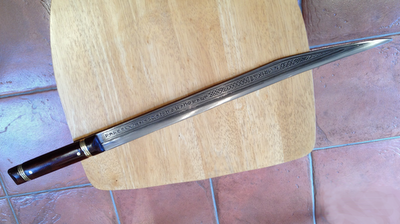 not called a longseax for nothingThe runes are a bit of a puzzle. By the late ninth century runes weren't really used much anymore: the Latin alphabet was more the thing (both for Latin and Old English--though Old English has those interesting little additions, e.g. eth, thorn and wynn). If I had to guess, I'd say this was a ceremonial piece (a parade seax) presented to a man who--for some reason or other--was hugely proud of his ethnic heritage. Or it could have been a weird magic thing: runes would have added a lovely hint of mystic woo. They don't say anything--it's just the futhorc, the runic alphabet, followed by the name Beagnoth (and a couple of symbols that no one understands). I think the runes were shaped by a smith who wasn't used to them; he got things a bit wrong here and there.
not called a longseax for nothingThe runes are a bit of a puzzle. By the late ninth century runes weren't really used much anymore: the Latin alphabet was more the thing (both for Latin and Old English--though Old English has those interesting little additions, e.g. eth, thorn and wynn). If I had to guess, I'd say this was a ceremonial piece (a parade seax) presented to a man who--for some reason or other--was hugely proud of his ethnic heritage. Or it could have been a weird magic thing: runes would have added a lovely hint of mystic woo. They don't say anything--it's just the futhorc, the runic alphabet, followed by the name Beagnoth (and a couple of symbols that no one understands). I think the runes were shaped by a smith who wasn't used to them; he got things a bit wrong here and there.Now for a bit of a wander into subjects I've read about but certainly can't claim to be expert--but about which I nonetheless have strong opinions (though weakly held, so if you actually know about this stuff I'd love to hear your thoughts).
First, pronunciation of seax. S, like the s in almost anything, e.g. saxophone. The ae, though, is a dipthong, pronounced something like the a in hat followed by the a in Cuba, with emphasis at the beginning. X, well, I'm guessing it wouldn't be far off the way we say it today: cks, as in, well, saxophone. So seax would end up sounding something like sah-ucks. Or, when in a hurry, sax as in... Oh, never mind.
Second, etymology (or maybe philology, or onomastics, not sure exactly which pot to put this in). Every now and again I hear the suggestion that Saxons were named for their seaxes, just as--supposedly--Franks were identified with their franciscae (throwing axes) and the Welsh got their name because the Angles called them wealh: foreigners. On this particular topic, I don't have a definite opinion. But because I like to make things up, I think it could be possible that some of the explanations stuck because of their use by old-school pedants of the time (I'm thinking of people like Isidore of Seville, or Bede) as nifty mnemonics for their students and readers. If you can remember that a certain set of people are called Franks, you're more likely to remember that the axes they're flinging at you are franciscae...
Third... Well, right this minute I can't even think of the term for the study of use-of-weapons-of-long-ago, so bear that in mind when temped to lean on the, ah, scholarship of this paragraph*. But, eh, here goes. In the sixth century, seaxes were ubiquitous, 'even women' were said to have worn them. They were not dedicated weapons of war but utility tools. They were used for everything: hack off a tree branch, butcher a deer, stab at your enemy if you'd stuck your spear in someone else and couldn't get it out in time. They came in all different sizes and shapes and levels of ornamentation, depending on the owner, their culture, and their particular requirements. Longseaxes were a later development. Technically, this longseax of Beagnoth's is known as a broken-backed seax.
Okay, back to firmer ground, that is, pure opinion. If I were making this replica according to the principles I've used in imagining Hild's world, I would have done three things differently.The hilt would have a pommel--this was a high-status item, and the Angles and Saxons of the time would not have been able to resist the opportunity for bling. The Anglo-Saxons loved their bling, the gaudier the better. They particularly liked garnets and were very skilled at bringing out their flash and sparkle by foiling the settings. (Gold foil behind a stone really enhances the shimmer of the stone.) Anglo-Saxons liked to display their wealth and status: subtlety was not a cultural value.The sheath (or perhaps scabbard might be a better term for something this size) would most probably have been highly ornamented. If it were leather, it would be tooled and dyed a brilliant colour. It would have metal chape and throat. But I think it's equally likely that with a blade of this size and status the scabbard would have been more like those for swords: wood, covered in leather and lined with fleece.The scabbard fittings would have been more like those for a sword: this blade is so long that that no one, unless they were an exceedingly stout giant, could wear it as a normal seax, suspended horizontally from and parallel to a belt. With something this size I'd want a baldric. And if I were a stout giant who could only afford plain brown leather, I'd put the loops on the other side of the sheath so the blade hung edge-up and so didn't cut it's way out in a week.By now I'm sure it will surprise no one to learn that Hild had a seax. But Hild's blade was nothing like Beagnoth's. I've imagined something half the size (though, even so, it was definitely too long for manners):
Hild leaned back from her half-eaten bread trencher and fingered her black-handled seax. It was a big blade, far bigger than any ten year-old should wear by rights, a slaughter seax.
[...]
The seax was handsome, with a black horn hilt, and a blade inlaid with patterns in a silver and copper mix, and hung edge-up in its supple black sheath suspended by two loops parallel to her belt, silver chape to her left. It had a battle edge with a very hard, sharp point. It could open a man's throat, cut twice-baked road bread, or joint a roast.I think of it as a gorgeous but deadly cross between a knife and machete. As Hild gets richer and more influential she may have gussied it up a bit: exchanged the sheath for one of embossed and tooled red or royal blue leather, swapped the silver chape and throat for figured, inlaid gold, put a whacking great jewel in the pommel (she is more fond of blue than red), etc. She's an Angle; tasteful understatement was not her thing. There again, Hild being Hild, she might have enjoyed wearing a stark black killing tool to enhance her reputation. It depends what would have served her purpose most readily. And that purpose changes as she changes.
In the middle of writing this post I realised that I just hadn't quite visualised the seax, so I got out my trusty Sharpie and drew an approximation of what it might look like, complete with sheath:
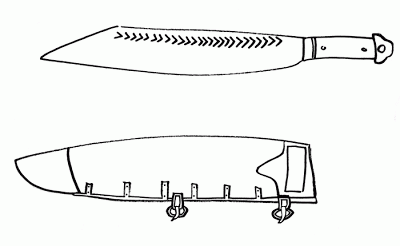 I dithered about the pommel; it's possible the handle could be plainer. On the sheath, the buckles would be at the top but it was easier to draw the buckles hanging down, so...
I dithered about the pommel; it's possible the handle could be plainer. On the sheath, the buckles would be at the top but it was easier to draw the buckles hanging down, so...If we say that Beagnoth's seax is mid-ninth century, that is, circa 850 CE (though as I've said I think it's later), and if we say that Hild's is right around 600 CE (though I've imagined it was a trophy from a skirmish fought a generation or two before she acquired it) then that's at least 250 years difference. Consider the change in knife design and production between knives of today and those of, say, 1750 and you begin to get an idea of how vast the cultural and manufacturing gap might have been.
I like them both. I think I might be developing seax acquisition syndrome...
* Anything I got right can be credited to Anglo-Saxons Weapons and Warfare by Richard Underwood (Tempus, 2001). Anything I got wrong is mine, all mine. Hey, I'm a novelist. I make shit up.
Published on October 30, 2012 04:30
October 26, 2012
Diptic: a nifty new photo app
I've discovered a nifty new app, Diptic, that let's you snap pix and then build a composite: a mini document of the day. Deliciously easy. So here's one from the day before yesterday.
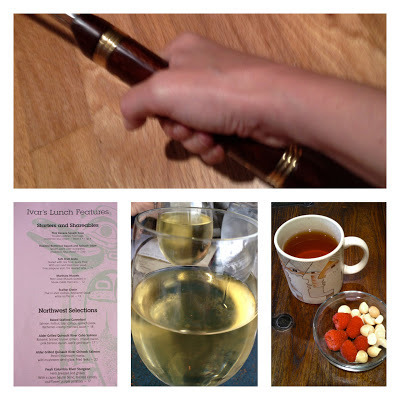 More on that top pic early next week. It's my new toy. Speaking of toys, here's a composite of my day yesterday:
More on that top pic early next week. It's my new toy. Speaking of toys, here's a composite of my day yesterday:
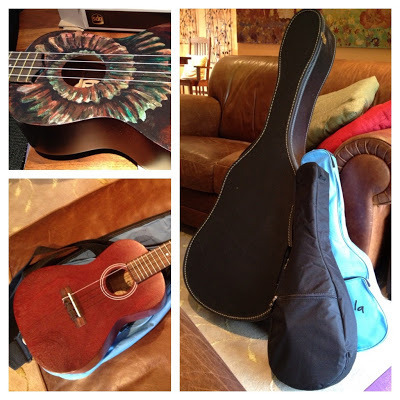 Top, of course, is Jeepster. Below that, a new ukulele strung with a low-G instead of high. It makes picking pretty different. And next to them is their big sister, a Yamaha acoustic guitar that I haven't touched for about fifteen years. Three makes family...
Top, of course, is Jeepster. Below that, a new ukulele strung with a low-G instead of high. It makes picking pretty different. And next to them is their big sister, a Yamaha acoustic guitar that I haven't touched for about fifteen years. Three makes family...
 More on that top pic early next week. It's my new toy. Speaking of toys, here's a composite of my day yesterday:
More on that top pic early next week. It's my new toy. Speaking of toys, here's a composite of my day yesterday: Top, of course, is Jeepster. Below that, a new ukulele strung with a low-G instead of high. It makes picking pretty different. And next to them is their big sister, a Yamaha acoustic guitar that I haven't touched for about fifteen years. Three makes family...
Top, of course, is Jeepster. Below that, a new ukulele strung with a low-G instead of high. It makes picking pretty different. And next to them is their big sister, a Yamaha acoustic guitar that I haven't touched for about fifteen years. Three makes family...
Published on October 26, 2012 11:57
October 20, 2012
Make my year: vote to approve Referendum 74
Ballots are hitting mailboxes this week in Washington State. We have ours. (And when I say 'we' I'm speaking loosely: Kelley got hers, but I'm not a citizen so I can't vote.)
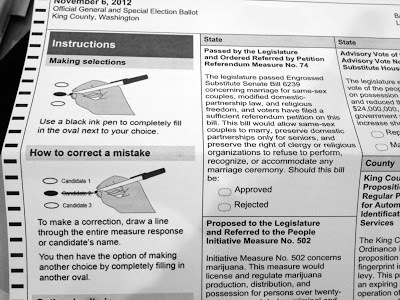 The local measure that concerns this household the most is, of course, a state referendum, Referendum Measure No. 74 which, if it passes, will make same-sex marriage legal here. Handily, it's in pride of place on the ballot: bang, right next to the little pictures showing you how to fill things in.
The local measure that concerns this household the most is, of course, a state referendum, Referendum Measure No. 74 which, if it passes, will make same-sex marriage legal here. Handily, it's in pride of place on the ballot: bang, right next to the little pictures showing you how to fill things in.
So we did. That is, Kelley did while I watched proudly:
 I would like all voters in Washington State to vote to approve R-74. If the measure is approved, and I'm cautiously optimistic (very cautiously: it would be the very first time that marriage equality has been approved at the ballot box in this country), then Kelley and I could get legally married. It's possible that we'd wait until marriage equality applied on a federal level before we actually had the ceremony--but maybe we wouldn't wait. We'll wait and see.
I would like all voters in Washington State to vote to approve R-74. If the measure is approved, and I'm cautiously optimistic (very cautiously: it would be the very first time that marriage equality has been approved at the ballot box in this country), then Kelley and I could get legally married. It's possible that we'd wait until marriage equality applied on a federal level before we actually had the ceremony--but maybe we wouldn't wait. We'll wait and see.
Meanwhile, it's fascinating watching the last-ditch efforts of the opposition. Their TV ads say, basically: not approving of homosexuals getting married doesn't mean you don't like those poor, pitiful queer people. And their voter pamphlet blurb says: If R-74 is approved and gays can get married then "women can be 'husbands' and men can be 'wives'." This is not only arrant nonsense but outright fear-mongering--because, yes, there are some people for whom the notion of 'upsetting the natural order of things' is both bewildering and frightening.
There are a few other, minor voting issues that concern us--y'know, who's going to be President, and Governor, and whether or not the police should just leave stoners the fuck alone and spend their time going after wife-beaters and murderers--but this is the one I want everyone to pay attention to.
If you or your loved ones are eligible to vote in Washington State I urge you to vote today to approve R-74. We'd be making history. Plus, it would make my day, or possibly year, or perhaps life.
 The local measure that concerns this household the most is, of course, a state referendum, Referendum Measure No. 74 which, if it passes, will make same-sex marriage legal here. Handily, it's in pride of place on the ballot: bang, right next to the little pictures showing you how to fill things in.
The local measure that concerns this household the most is, of course, a state referendum, Referendum Measure No. 74 which, if it passes, will make same-sex marriage legal here. Handily, it's in pride of place on the ballot: bang, right next to the little pictures showing you how to fill things in.So we did. That is, Kelley did while I watched proudly:
 I would like all voters in Washington State to vote to approve R-74. If the measure is approved, and I'm cautiously optimistic (very cautiously: it would be the very first time that marriage equality has been approved at the ballot box in this country), then Kelley and I could get legally married. It's possible that we'd wait until marriage equality applied on a federal level before we actually had the ceremony--but maybe we wouldn't wait. We'll wait and see.
I would like all voters in Washington State to vote to approve R-74. If the measure is approved, and I'm cautiously optimistic (very cautiously: it would be the very first time that marriage equality has been approved at the ballot box in this country), then Kelley and I could get legally married. It's possible that we'd wait until marriage equality applied on a federal level before we actually had the ceremony--but maybe we wouldn't wait. We'll wait and see.Meanwhile, it's fascinating watching the last-ditch efforts of the opposition. Their TV ads say, basically: not approving of homosexuals getting married doesn't mean you don't like those poor, pitiful queer people. And their voter pamphlet blurb says: If R-74 is approved and gays can get married then "women can be 'husbands' and men can be 'wives'." This is not only arrant nonsense but outright fear-mongering--because, yes, there are some people for whom the notion of 'upsetting the natural order of things' is both bewildering and frightening.
There are a few other, minor voting issues that concern us--y'know, who's going to be President, and Governor, and whether or not the police should just leave stoners the fuck alone and spend their time going after wife-beaters and murderers--but this is the one I want everyone to pay attention to.
If you or your loved ones are eligible to vote in Washington State I urge you to vote today to approve R-74. We'd be making history. Plus, it would make my day, or possibly year, or perhaps life.
Published on October 20, 2012 12:31
October 8, 2012
The neurochemistry of story, the dramatic arc, and empathy
Neuroeconomist Paul Zak (author of The Moral Molecule: The Source of Love and Prosperity) has done some work in his lab tracking the measurable effects of story (changing blood chemistry, i.e. levels of oxytocin and cortisol, and areas of brain engagement, using fMRI scans)--the attention, distress, and empathy triggered by same--and mapping them to the classic dramatic arc, first proposed by Gustav Freytag about 150 years ago, of Exposition > Rising Action > Climax > Falling Action > Denouement.
I doubt it will surprise any reader (or viewer) to learn that a good story influences our brain chemistry which in turn influences our behaviour. I've talked about this before: stories work by triggering mirror neurons so that we recreate the experience of others inside ourselves. In other words, story lets us walk in others' shoes without leaving the house and without having to take anyone's shoes away from them.
Empathy is what makes us social animals. Many people believe that its these social propensities that make us human.
What is certain is that story changes us. Story helps make us who we are. Creating story--and sharing the stories others have created--is the most important job of our lives. In a very real sense, story is what makes us who we are.
Watch the video--for experimental purposes I would have tweaked the story of the little boy, sharpened and clarified the arc--but it's instructive:
(via brain pickings, thanks to Karina Sandweg)
I doubt it will surprise any reader (or viewer) to learn that a good story influences our brain chemistry which in turn influences our behaviour. I've talked about this before: stories work by triggering mirror neurons so that we recreate the experience of others inside ourselves. In other words, story lets us walk in others' shoes without leaving the house and without having to take anyone's shoes away from them.
Empathy is what makes us social animals. Many people believe that its these social propensities that make us human.
What is certain is that story changes us. Story helps make us who we are. Creating story--and sharing the stories others have created--is the most important job of our lives. In a very real sense, story is what makes us who we are.
Watch the video--for experimental purposes I would have tweaked the story of the little boy, sharpened and clarified the arc--but it's instructive:
(via brain pickings, thanks to Karina Sandweg)
Published on October 08, 2012 10:43
October 4, 2012
Presidential debate, TV, and drinking games
You know the kind of afternoon when the rewriting that's gliding along suddenly isn't? Yeah, like that. And then you remember there's a presidential debate and you haven't made dinner and there's only a few beers in the fridge, but, hey, there's wine, and vodka in the freezer, and a whole lot of mysterious dusty bottles in lower cupboards so you think, Ah, fuck it, and turn on the TV...
...and, oh god, you can spot a bullet-proof tie when you see one, spread out so wide on the presidential chest, and you're thinking that man must be dying under those burning lights, and his opponent doesn't have to wear armour--he has time to kick back in the evening and drink Mormon-type drinks after a hard day's debate prep, while the exhausted and armoured guy has been, y'know, dealing with dead Ambassadors to Libya and Israel posturing at Iran and Turkey shooting at Syria, and well, shit, this isn't going to go well.
But then you think, Hey, drinking game! (Because that's such a good idea with no food ballast after a hard day's work...) And every time Mr. Willfull Untruths says Crush, we clink, we drink, and every time he says China we clink, we drink, and at some point a neighbour drops by, and when she's gone we find the beer and wine has become vodka shots and after a blur I find I'm eating dinner after all and now we're in the middle of watching some terrible movie with Ashley Judd and Tommy Lee Jones and everyone is shooting at everyone else in the middle of a dixieland jazz funeral and Judd is buried alive in a coffin with a dead grey person who looks about the same colour as all presidents when they've been on the job more than two years.
And, Damn, I say to Kelley, who would want that fucking job? Not me, she says, and we agree we really should not watch so much TV, it's bad for us.
...and, oh god, you can spot a bullet-proof tie when you see one, spread out so wide on the presidential chest, and you're thinking that man must be dying under those burning lights, and his opponent doesn't have to wear armour--he has time to kick back in the evening and drink Mormon-type drinks after a hard day's debate prep, while the exhausted and armoured guy has been, y'know, dealing with dead Ambassadors to Libya and Israel posturing at Iran and Turkey shooting at Syria, and well, shit, this isn't going to go well.
But then you think, Hey, drinking game! (Because that's such a good idea with no food ballast after a hard day's work...) And every time Mr. Willfull Untruths says Crush, we clink, we drink, and every time he says China we clink, we drink, and at some point a neighbour drops by, and when she's gone we find the beer and wine has become vodka shots and after a blur I find I'm eating dinner after all and now we're in the middle of watching some terrible movie with Ashley Judd and Tommy Lee Jones and everyone is shooting at everyone else in the middle of a dixieland jazz funeral and Judd is buried alive in a coffin with a dead grey person who looks about the same colour as all presidents when they've been on the job more than two years.
And, Damn, I say to Kelley, who would want that fucking job? Not me, she says, and we agree we really should not watch so much TV, it's bad for us.
Published on October 04, 2012 11:11
October 1, 2012
Birthday experiments
Well, first of all nature ran an experiment of her own: producing, for the very first time in my 17 years in Seattle, and absolutely perfect day for my birthday. Seriously, it could not have been more perfect. Cool, bright, clear in the morning, brilliant just-right sunshine in the afternoon: about 70 degrees. And the neighbourhood was quiet, with the occasional stir of wind in the tops of the trees (which are already beginning to sound papery; autumn is coming) and flick of bird wings. Wasps buzzed. Spiders hung on their webs, assessing best placement for the next couple of weeks.
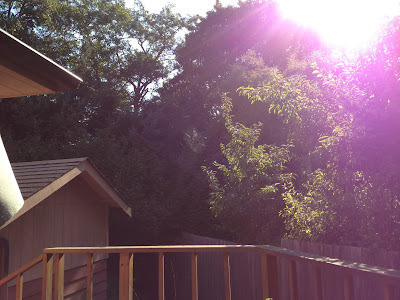
I spent a lot of the day talking--with friends and family in the morning, and Kelley in the evening--eating (more anon) and drinking (ditto).
In between I worked on Hild, with a little help from a food experiment:
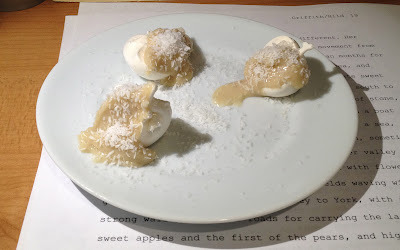
The white base is meringue--the tiny dots you put on the baking sheet to test whether the main meringues are cooked. This time, instead of just munching them up, nodding, and getting the main event out of the oven, I decided to play. I added a dab of macadia butter to each and sprinkled them with grated coconut. It turns out they make truly delicious treats. They certainly powered a lot of Hilding.
Another variation, this time with added chocolate:
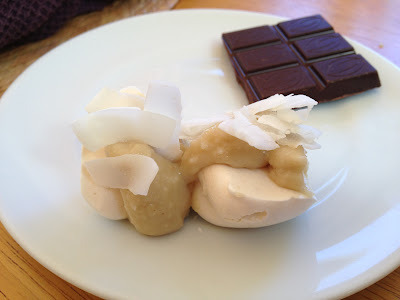
This time instead of shredded fresh coconut it's dried shaved coconut--which isn't as sweet, and offsets the sweeter meringue nicely. Plus they look more elegant. Anyway, I took the whole plateful outside during my afternoon break from Hild to eat with tea, reading, and ukulele time:
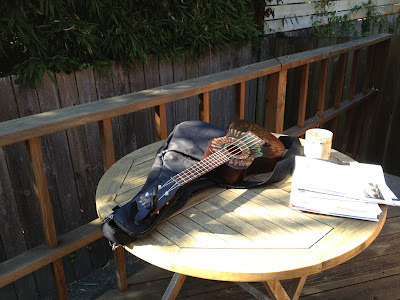
Then more Hilding. Then time for serious food experiments, this time involving Indian food.
I love India food, but I haven't had it for about a year because all the things it comes with, that are part of the necessary experience--wheat, rice--are bad for me. So this time we decided to forgo the samosas (sigh), substitute mulligatawny soup (delicious), and instead of roti make a kind of buckwheat pancake thing that ended up looking (according to a Twitter friend, @kathygori) like Ethiopian Injera:
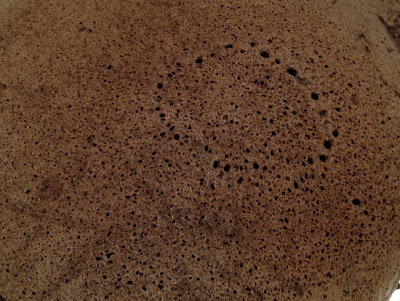
And in fact their texture was very similar to the Ethiopian bread I've used to scoop up meat. And it's nothing but good for you: buckwheat isn't a grass at all but a dried and ground flower seed closely related to rhubarb. And it was very, very good at scooping up lamb drenched in spices and accompanied by (hey, it was my birthday, after all) a very little bit of white rice.
Of course, the fact that the meal was accompanied with entirely too much Champagne and beer (forgot to take a picture til we were clearing up):
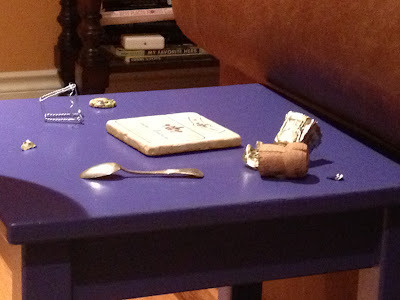 probably helped. For dessert we'd planned the aforementioned Big Girl Meringues, with fresh nectarines and whipped cream but, well, we never got around to that part.
probably helped. For dessert we'd planned the aforementioned Big Girl Meringues, with fresh nectarines and whipped cream but, well, we never got around to that part.
Tomorrow is another day. Oh, wait, that's today :) Well, you know what I'll be doing for the rest of the week: eating, drinking, and enjoying this unprecedented sun-in-October weather:
 Life is bloody good.
Life is bloody good.

I spent a lot of the day talking--with friends and family in the morning, and Kelley in the evening--eating (more anon) and drinking (ditto).
In between I worked on Hild, with a little help from a food experiment:

The white base is meringue--the tiny dots you put on the baking sheet to test whether the main meringues are cooked. This time, instead of just munching them up, nodding, and getting the main event out of the oven, I decided to play. I added a dab of macadia butter to each and sprinkled them with grated coconut. It turns out they make truly delicious treats. They certainly powered a lot of Hilding.
Another variation, this time with added chocolate:

This time instead of shredded fresh coconut it's dried shaved coconut--which isn't as sweet, and offsets the sweeter meringue nicely. Plus they look more elegant. Anyway, I took the whole plateful outside during my afternoon break from Hild to eat with tea, reading, and ukulele time:

Then more Hilding. Then time for serious food experiments, this time involving Indian food.
I love India food, but I haven't had it for about a year because all the things it comes with, that are part of the necessary experience--wheat, rice--are bad for me. So this time we decided to forgo the samosas (sigh), substitute mulligatawny soup (delicious), and instead of roti make a kind of buckwheat pancake thing that ended up looking (according to a Twitter friend, @kathygori) like Ethiopian Injera:

And in fact their texture was very similar to the Ethiopian bread I've used to scoop up meat. And it's nothing but good for you: buckwheat isn't a grass at all but a dried and ground flower seed closely related to rhubarb. And it was very, very good at scooping up lamb drenched in spices and accompanied by (hey, it was my birthday, after all) a very little bit of white rice.
Of course, the fact that the meal was accompanied with entirely too much Champagne and beer (forgot to take a picture til we were clearing up):
 probably helped. For dessert we'd planned the aforementioned Big Girl Meringues, with fresh nectarines and whipped cream but, well, we never got around to that part.
probably helped. For dessert we'd planned the aforementioned Big Girl Meringues, with fresh nectarines and whipped cream but, well, we never got around to that part.Tomorrow is another day. Oh, wait, that's today :) Well, you know what I'll be doing for the rest of the week: eating, drinking, and enjoying this unprecedented sun-in-October weather:
 Life is bloody good.
Life is bloody good.
Published on October 01, 2012 12:01



